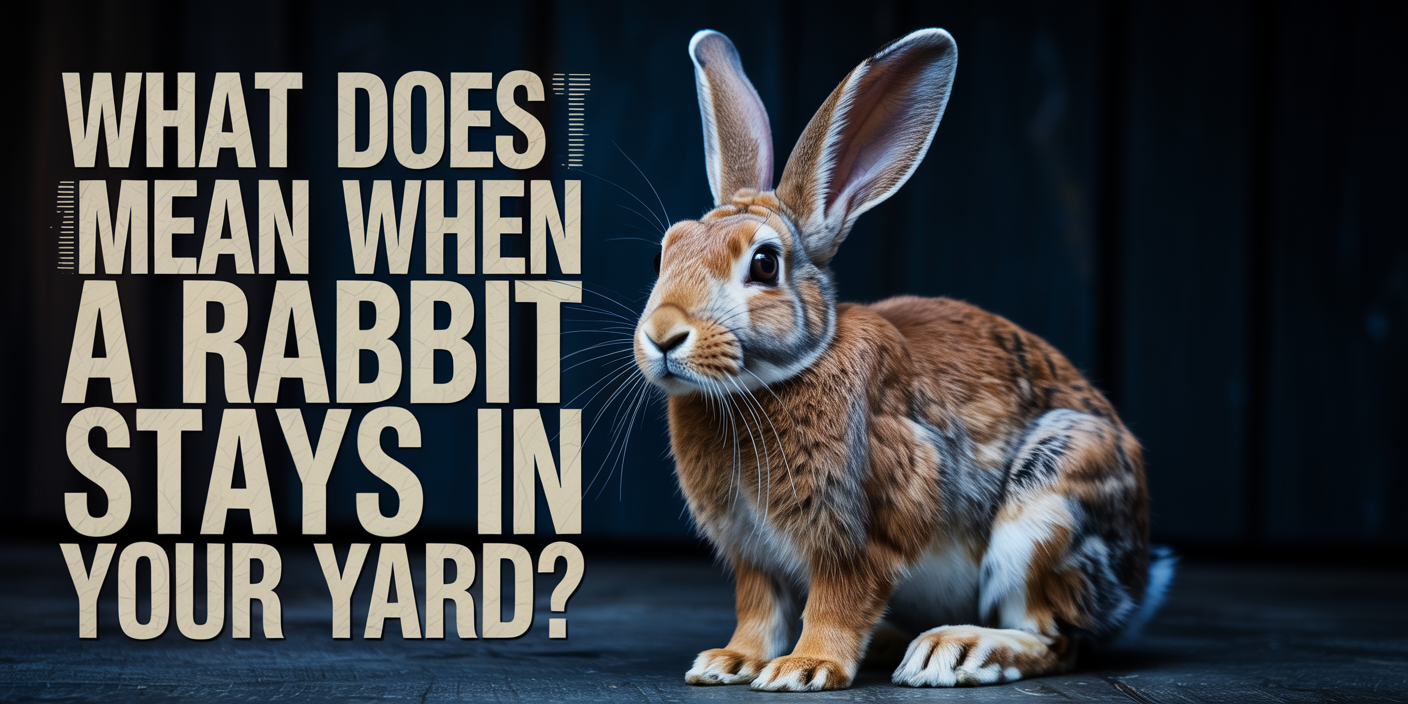A rabbit staying in your yard usually means it’s found food, shelter, and safety. It may also be nesting nearby or using the area to feed regularly.
Rabbits might seem like quiet, harmless guests, but when one keeps hanging around your yard, it’s worth paying attention. What starts as a cute sighting can quickly turn into garden damage, hidden nests, or even a rabbit family settling in for the long haul.
In this guide, we’ll break down why rabbits choose certain yards, what their behavior means, and how to tell when it’s time to step in, or call a wildlife expert for help.
Learn more: What kills rabbits in your yard?
What does it mean when a rabbit stays in your yard?
If a rabbit keeps returning or settles in your yard, it’s likely found a perfect mix of food, shelter, and safety. Yards with garden beds, tall grass, bushes, or open compost piles are basically rabbit paradise; easy to hide in, easy to eat from, and mostly undisturbed.
In some cases, the rabbit may have a nest nearby or be preparing to raise young, especially during spring and summer. Their presence often signals that your property is part of their regular routine or territory, which means they could be sticking around longer than you’d expect.
Why do rabbits choose certain yards over others?
Rabbits are picky about where they settle, and they’re naturally drawn to yards that feel quiet, lush, and protected. If your yard has tall grass, dense shrubs, woodpiles, or low-traffic areas, it becomes a cozy shelter from predators and harsh weather.
They’re also big fans of easily accessible food like vegetable gardens, flowerbeds, birdseed, and even fallen fruit. Add in a water source like a birdbath or dripping hose, and your yard becomes a full-service bunny buffet that’s hard for them to resist.
Should you be concerned about a rabbit staying in your yard?
At first glance, a rabbit might not seem like a problem; but over time, they can cause real damage. Rabbits love to chew on tender plants, dig around garden beds, and nibble bark off young trees, which can ruin your landscaping and even kill certain plants.
There’s also the potential for bigger issues, like attracting predators such as foxes, hawks, or coyotes that follow prey animals into residential areas. Plus, if one rabbit feels comfortable enough to stick around, it may be a sign that more are on the way, especially during breeding season.
How can you tell if there’s a rabbit nest nearby?
Rabbit nests are often hidden in plain sight and can be easy to miss if you don’t know what to look for. They typically appear as shallow depressions in the ground, lightly covered with grass, leaves, and tufts of fur pulled from the mother rabbit’s belly to insulate her young.
You might also notice increased rabbit activity in a specific area, such as repeated visits to the same patch of lawn or garden bed. If you see disturbed mulch, narrow trails in tall grass, or sudden movement from a hiding rabbit, there’s a good chance a nest is nearby.
What should you do if a rabbit won’t leave?
If a rabbit keeps returning to your yard, the first step is to remove anything that’s making it feel at home. Keep your lawn trimmed, secure your garden with fencing, clean up fallen fruit or birdseed, and remove brush piles or low-lying shrubs where they might hide.
Avoid handling or disturbing a rabbit nest directly, especially if babies are present. Instead, use gentle deterrents like motion-activated sprinklers, reflective garden tape, or predator scent granules to make your yard less appealing without harming the animal.
When should you call a wildlife removal expert?
You should contact a wildlife expert if a rabbit has nested too close to your home, refuses to leave despite deterrents, or is causing noticeable damage. Nests near walkways, patios, or dog runs can create stress for the animal and risk for pets or small children.
Professionals can assess the situation, safely relocate the rabbit if necessary, and help you secure your yard to prevent future visits. They’ll also make sure all actions follow local wildlife laws, which often protect rabbits and restrict how they can be handled.
How AAAC Wildlife Removal helps with rabbit problems
At AAAC Wildlife Removal, we specialize in humane, effective solutions for managing unwanted wildlife, including rabbits that have overstayed their welcome. Our team begins with a full property inspection to identify hiding spots, feeding areas, and signs of nesting, then creates a custom plan tailored to your yard.
We use safe relocation practices, secure any entry points or shelter zones, and offer expert advice on long-term prevention. Whether it’s a single rabbit or an entire family, we’ll help restore balance to your outdoor space without harming the animals or your landscape.
Stop the Spread Before It Starts
Seeing a rabbit lounging in your yard might seem harmless at first, but it’s often a sign that your property has become a hotspot for nesting, feeding, or long-term shelter. Left unchecked, one quiet visitor can lead to plant damage, predator attraction, or even a full-blown rabbit colony.
Understanding what draws rabbits in, and how to respond, makes all the difference. With the right mix of prevention and professional help from AAAC Wildlife Removal, you can keep your yard safe, clean, and bunny-free without harming local wildlife.
Ready to Reclaim Your Yard from Unwanted Rabbits?
If a rabbit has made your yard its new hangout; or worse, its nesting ground, it’s time to call in the pros at AAAC Wildlife Removal. We’ll safely assess the situation, remove the problem, and help you rabbit-proof your property for good.
Don’t wait for one bunny to turn into many. Contact AAAC Wildlife Removal today for fast, humane, and effective rabbit control you can trust.




